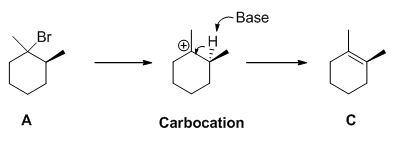
a)
Interpretation:
The product of the reaction has to be predicted and the mechanism of the reaction has to be shown.
Concept introduction:
Elimination reaction: An elimination reaction is removal of two substituents in a molecule and forms
E1 elimination:

b)
Interpretation:
The product of the reaction has to be predicted and the mechanism of the reaction has to be shown.
Concept introduction:
Elimination reaction: An elimination reaction is removal of two substituents in a molecule and forms alkene. An elimination reaction is one or two-step process which based on the mechanism when two substituents removed from the molecule in single step is called E2 reaction. When two substituents are removed from the molecule in two steps is called E1 reaction.
E1 elimination:
Alkyl halide forms carbocation by the removal of bromine followed by the abstraction of the proton from the β-carbon atom in two steps which leads to the product as an alkene.

c)
Interpretation:
The product of the reaction has to be predicted and the mechanism of the reaction has to be shown.
Concept introduction:
Elimination reaction: An elimination reaction is removal of two substituents in a molecule and forms alkene. An elimination reaction is one or two-step process which based on the mechanism when two substituents removed from the molecule in single step is called E2 reaction. When two substituents are removed from the molecule in two steps is called E1 reaction.
E1 elimination:
Alkyl halide forms carbocation by the removal of bromine followed by the abstraction of the proton from the β-carbon atom in two steps which leads to the product as an alkene.

Want to see the full answer?
Check out a sample textbook solution
Chapter 11 Solutions
ORGANIC CHEMISTRY-EBOOK>I<
- Predict the product(s) of the following reactions, including stereochemistry when necessary and identify the mechanism of each substitution reaction (SN1 vs SN2). Draw the reaction mechanism (reaction arrows) for any one of the reactions to show how the product is formed.arrow_forwardComplete the following reactions by filling in any missing reactants, reagents or products. a) Zn(Hg) conc. HCl b) ОН ? с) ОН РСС CH,Cl,arrow_forwardGive each product in the series of reactions shown below CH;CI HNO3 А OH CUCN E Sn NaNO2, HCI. D ►F AICI3 H2SO4 HCI 0°Carrow_forward
- The accepted mechanism for a rearrangement reaction is shown below. "Q Ph (1) (ii) Ph Ph HO™ fast Ph Ph HO O™ slow Ph aufae .Ar² LOH HO™ fast Draw a curly arrow mechanism for this transformation. Sketch an energy profile for this reaction, showing approximate relative energies for the reactants, intermediates, transition states, and products. HQ Ph (iii) When DO™ was used as the reagent, the rate of product formation was same as for HO™. Explain why this result shows that the third step is fast and cannot be rate-determining. Ph (iv) Write the predicted rate equation for this mechanism, and show how it was derived. (v) The starting diketone may have two different aryl groups, as shown below. Propose a ¹³℃ labelling experiment that would allow you to distinguish which of the two aryl groups had migrated in this situation. OH AR²0- Ar¹ C Carrow_forwardComplete the reaction by providing the starting material/reagent/products. Match each item to a choice: HO OH NO₂ Cl₂ FeCl3 HO SO3 conc. H₂SO4 KMnO4 H₂O NO₂ NO₂ CIarrow_forwardFor each of the reactions indicate which reactant is the nucleophile and which is the electrophile.arrow_forward
- 4. What are the products obtained from the following elimination reaction? Indicate the major product. CH3 CH,CH,CCH, H2O +arrow_forwardPericyclic Reactions: Convert 1a to 1b Indicate what type of reactions and mechanisms occured in each step. Indicate reagents/conditions.arrow_forwardUsing your reaction roadmap as a guide, show how to convert cyclohexane into hexanedial. Show all reagents and all molecules synthesized along the way.arrow_forward

 Organic ChemistryChemistryISBN:9781305580350Author:William H. Brown, Brent L. Iverson, Eric Anslyn, Christopher S. FootePublisher:Cengage Learning
Organic ChemistryChemistryISBN:9781305580350Author:William H. Brown, Brent L. Iverson, Eric Anslyn, Christopher S. FootePublisher:Cengage Learning Organic Chemistry: A Guided InquiryChemistryISBN:9780618974122Author:Andrei StraumanisPublisher:Cengage Learning
Organic Chemistry: A Guided InquiryChemistryISBN:9780618974122Author:Andrei StraumanisPublisher:Cengage Learning EBK A SMALL SCALE APPROACH TO ORGANIC LChemistryISBN:9781305446021Author:LampmanPublisher:CENGAGE LEARNING - CONSIGNMENT
EBK A SMALL SCALE APPROACH TO ORGANIC LChemistryISBN:9781305446021Author:LampmanPublisher:CENGAGE LEARNING - CONSIGNMENT



